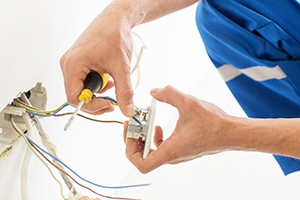With the introduction of the 18th Edition the decision-making process for inclusion of overvoltage protection in electrical installations has changed. Here, Dave Enefer, Devices Product Manager at Crabtree, one of Electrium’s leading brands in electrical components, looks at the latest requirements for overvoltage protection.
In certain circumstances overvoltage protection is mandatory. For all other situations a risk assessment is necessary However, if there is no risk assessment carried out over voltage protection must be installed and in single unit dwellings the final decision is made on a value judgement.
Overvoltage Protection Requirements
Firstly, we must look at the area where protection against overvoltage must be provided. Designers must consider the consequences of overvoltage, and decide which circumstances apply to each type of building / installation under consideration. Over voltage protection is mandatory where the consequences of overvoltage can result in
- Serious injury to persons or loss of human life (e.g. nursing homes, care facilities, hospitals)
- Interruptions to public services (e.g. 999 call centres, communications & transport networks etc)
- Damage to cultural heritage (e.g. loss of irreplaceable artefacts records etc)
- Interruption to industrial & commercial activity (e.g. banking, online services data centres etc)
- Affects a large number of individuals in one location (e.g. high-rise buildings etc)
For housing providers, the last one may be the most relevant. Where the above consequences of overvoltage could occur, protection is a requirement. (See Regulation 443.4).
All Other Applications – Carry Out a Risk Assessment
For circumstances other than those explained above a risk assessment must be carried out to determine if protection against transient  overvoltage is necessary. The risk assessment calculation is now based upon a formula that uses values that are given in Table 443.1 and on values related to geographical locations shown in fig 44.2, which is a map of the UK. These values are used with figures that are determined by the lengths of supply cables to the origin of the installation to make a calculation.
overvoltage is necessary. The risk assessment calculation is now based upon a formula that uses values that are given in Table 443.1 and on values related to geographical locations shown in fig 44.2, which is a map of the UK. These values are used with figures that are determined by the lengths of supply cables to the origin of the installation to make a calculation.
If the calculated risk level is 1000 or less, then protection is required. Readers should consult BS7671 for the full details of the risk assessment criteria & equation
Single Dwellings
An added consideration applies for single unit dwellings. Overvoltage will be required if no risk assessment is carried out or if the total value of the installation and the equipment therein justifies such protection. Or, as the regulations put it, overvoltage protection can be omitted if the total value of the installation and the equipment within does not justify such protection.
So, how should designers look at this? In or out? Surely the cost of a Surge Protection Device (SPD) is a tiny fraction of the total value of the installation and the equipment?
To make the decision to include protection it’s necessary to know the value of the electrical installation. An average domestic rewire cost is apparently around £3,000. Next step is to add in the value of the equipment in the installation that can be damaged by overvoltage.
Typically, that would include quite a few items of fixed equipment e.g. central heating boiler, heating controls, intruder alarm, smoke alarms, CO alarm, LED lighting, possibly a PV installation or an EV charger all of this would cost several thousand pounds to replace.
While some may not think it appropriate to include portable appliances such as freezer, fridge, washing machine, dryer, oven, microwave, broadband router, games console TVs. Laptop etc, these too can be permanently damaged by overvoltage.
The low cost of investment in SPDs suggests that individual household installations should include the benefits of overvoltage protection, as standard, from January 2019 just like many other applications where overvoltage is mandated.
For more information visit www.electrium.co.uk/crabtree






